Data publicării:
Stories from the Kiseleff Road, as seen today, over time
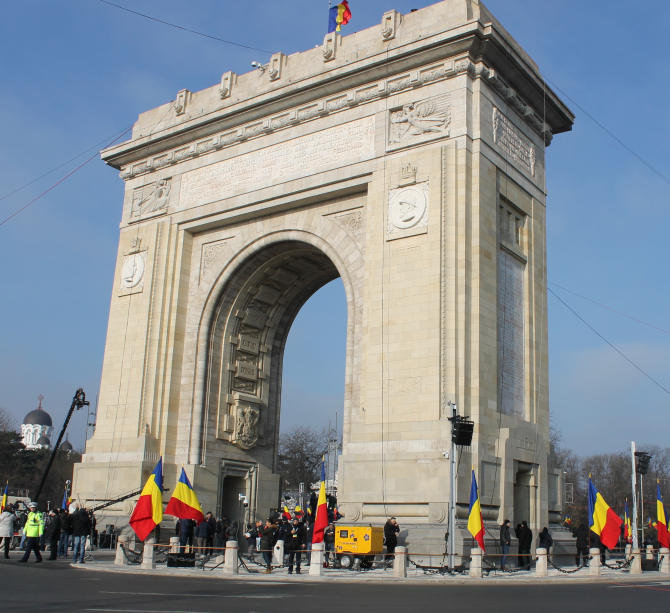
Kiseleff Road is one of the most famous roads in Bucharest, stretching from Victoriei Square to the Arcul de Triumf. Until 2017, the Kiseleff Road stretched to the Free Press Square (Piața Presei Libere), but after the death of King Michael I, the portion between the Arcul de Triumf and the Free Press Square is bearing his name.
“Would you like to meet on Saturday evening
In a small tavern by the Road
Where a piano and a violin play
And where nobody can see us”
Jean Moscopol (1903-1980)
As Grigore Ionescu captures in “Bucharest - Historical and Artistic Guide”, in 1938, “leaving aside the two main streets that come from the South and end in Victoriei Square, Lascăr Catargiu Boulevard and Calea Victoriei, two roads, among the other six radial streets that leave from this point to different destinations, have an original appearance worth noting: Gheorghe Buzdugan Boulevard and the Kiseleff Road.”
Gheorghe Buzdugan is the old name of the Aviators' Boulevard (Bulevardul Aviatorilor), and, at the date of the publication of this Guide (1938) it held the name of the politician and jurist who lived between 1867 and 1929 and who was also a member of the Regency instituted after the Prince Carol’s second renunciation of the throne. The regency was a consequence of the dynastic Crisis, which was generated by the abdication of Carol (II) in 1925, and it ended with the King’s return in 1930. In fact, the name of the politician is not the only previous name of the Aviators’ Boulevard. It was also called the Jianu Road (paved with macadam, in 1914), and after “Gheorghe Buzdugan”, “General Stalin” was its new name. It has been holding the present name, Aviatorilor, since 1962. The current Boulevard was divided “into two almost equal parts from the gigantic and bustling aviation monument, a remarkable work of the sculptor Lidia Kotzebue (and Iosif Fekete), and it borders on the West a neighborhood with the most elegant villas, as well as the Filipescu Park, where the beauty lover could wonder by foot for hours and find enough corners, buildings and gardens, which will awaken his admiration and will delight his eyes.”(Grigore Ionescu)
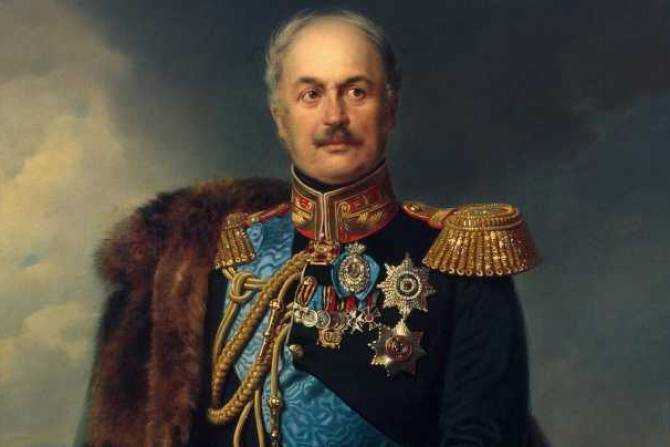
The Russian Generalul Pavel Kiseleff Foto: wikipedia.org
Coming back to the Kiseleff Road, it has born the name of the brilliant Russian general Pavel Kiseleff (1788-1872) from as early as 1844. Basically, when the name was given to it, the Russian general was still alive. Among the important events that link his name to the Kiseleff Road, according to other documentary sources (libertatea.ro) we find: the ceremony for the reception of ruler Alexandru Ioan Cuza in 1959, the handing over of the Key of the City to Carol I by the mayor of the Capital D.I. Brătianu or the organizing of the first examinations for obtaining a driver's license. Between 1914-1916 the famous flowers fights took place on Kiseleff, which were captured by Ștefan Luchian in the painting: ”Flowers Fight on the Road”.
Also, his name is related to the construction of several buildings and the adoption of urbanistic measures that last until today, among which: the construction of the Colentina and Filantropia hospitals, the systematization of Bucharest on its east-west axis by the abolition of small cemeteries in the court of numerous churches and the establishment of Bellu, Eternitatea and Calvin cementeries, the building of barriers around the city and many more.
The Kiseleff Road and Cișmigiu Park - the fruit of creativity of the same landscape artist
Thus, Grigore Ionescu tells us further that “The Kiseleff Road, which the Bucharest residents briefly call the extension of Calea Victoriei to the North, is the most beautiful street of the Capital and it’s the favorite place for a quiet walk for the people living in Bucharest. Cut along the forest which used to border Bucharest on this side, in 1832, by the Russian General Count Paul Kiseleff, whose name it bears, the Kiseleff Road was consummate. The gardens that surround it on both sides were arranged by Gheorghe Bibescu and his brother and successor to the Throne, Barbu Știrbey, with the help of the landscape architect Meyer, who had drawn the plan of the Cișmigiu garden ”. This is Carl Friedrich Wilhelm Meyer (1817-1852). According to arhivadearhitectura.ro, by demanding a foreign gardener, "the development of residential areas around public gardens was desired.”
G. Ionescu describes the Kiseleff Road as being “green, blooming, with echoing birds songs, in summer, and covered by snow or sparkling with hoar-frost, in winter. Therefore, the road offers enchanting perspectives to the eye over its entire length and throughout all the seasons. The palaces, public monuments, museums, as well as private villas, built along it in different eras and styles, are all surrounded by gardens or hidden among charming groves.”
The first one among the important objectives mentioned by the author of the “Historical and Artistic Guide” is the Monument of the Heroes of the Teaching Body. which does not exist anymore. The bronze monument, erected in 1930, was imposing and it consisted of 3 legionaries (Romans!) who “on a shield raised to the sky, were carrying the corpse of a comrade fallen in battle”. The monument was considered a tribute brought by the Teaching Body, through the work of sculptors Ion Jalea and Arthur Verona, to its members who died in the War of National Unification.
The Natural History Museum (the current Grigore Antipa National Museum of Natural History) dates from 1836 and was founded by Prince Alexandru Ghica and his brother Grigore. We learn from Ionescu's guide that the first collection pieces were sent as a gift by the museum in Turin. Initially, the museum functioned in the building of St. Sava High School - on the place of the current University Square, later it was moved to a wing of the University, and since 1906 it is in its current location.
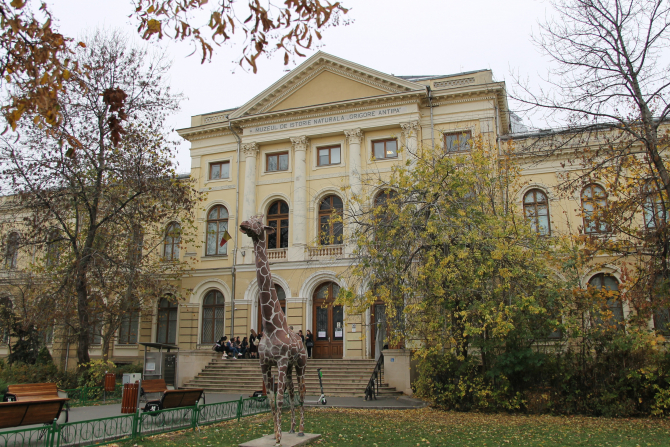
The Grigore Antipa National Museum of Natural History Photo: Crișan Andreescu
The Geological Institute (the current National Museum of Geology) – “A large building, constructed in neo-Romanian style, in 1906, following the plans of architect Victor Ștefănescu, and whose initiator and first director, from 1906 to 1930, was professor Ludovic Mrazec.”
The Carol I National Museum (currently, the National Museum of the Romanian Peasant) was built according to the plans of architect N. Ghika-Budești. It was set up in 1906 – “the cornerstone of a new building was only laid in 1912 - the National Museum, which functioned for a while in the old building located in the same place, was intended to gather together collections of Romanian art from all fields of activity, from prehistoric times to the present day.” The director of the museum was Professor Al. Tzigara-Samurcaș.
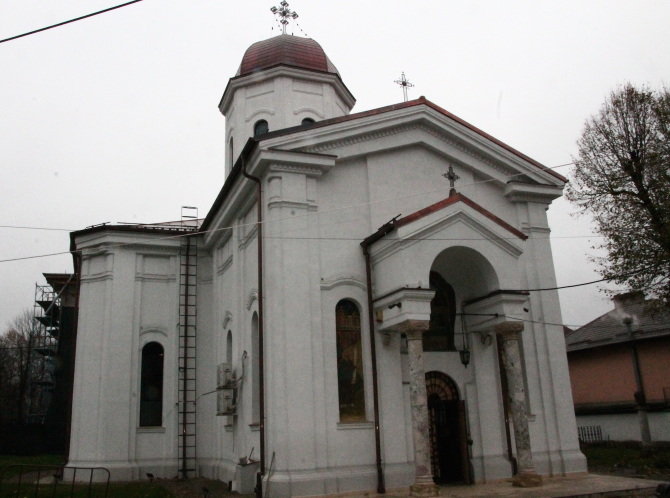
The Church of Mavrogheni, Foto: Crișan Andreescu
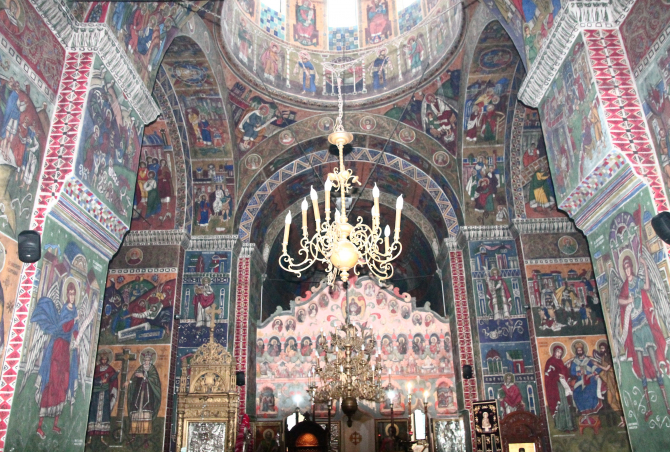
The Church of Mavrogheni or the Healing Spring – “is located on Monetăriei Street, in the back of a courtyard, across the road from the National Museum. It was built in 1789 by the fanariot Niculae Mavrogheni and his wife Maria Doamna, who dedicated it to the Ecaton Dapiliani (or Ecatontapiliani) Monastery from the island of Paros, his homeland.”
We also find from Grigore Ionescu that "the extravagant Phanariot ruler, who often used to harness his stags instead of horses for his carriage, had also built a royal house near the church. Around the house he had then arranged a large and beautiful garden, which he endowed with many kiosks and fountains, thus creating a picturesque party corner for himself and the boyars of Bucharest during his time, of which today there is only the memory remaining.”
According to the Atlas-Guide “The History and Architecture of the Places of Worship in Bucharest” (vol. II), the Church of the Healing Spring from “Cișmeaua Mavrogheni” (“Mavrogheni Fountain”) was built between 1786-1787 by the two above mentioned spouses, as a form of gratitude for the cure of an incurable disease of their daughter - “it was dedicated to the monastery of Ecatontapiliani (the one with 100 portals, founded by Empress Elena) from the island of Paros, the birthplace of the ruler. After 1864, the Healing Spring Church served the neighborhood, but also served as a monastery church. It was endowed by the founder with lands, pavilions and mills.” The same source informs us that the tombs of Ion Heliade Rădulescu, Princess Zoe Văcărescu, the Filipescu family, Prince Mihail Șuțu and his wife are located around the church.

The Fountain in the courtyard of the Church of Mavrogheni Photo: Crișan Andreescu
We also find from Atlas-Guide that “the ruler endowed the capital with a network of fountains with spring water, brought from a distance, and the was on the corner of Strada Monetăriei and Kiseleff Road, where there still is a fountain. For this reason it was called. At the same time with the church, royal houses with kiosks were built, in a beautiful garden. Around 1789, a printing house functioned in these houses, and it later became the property of Ion Heliade Rădulescu, who printed here the Organic Regulation (Regulamentul organic) and the Romanian Courier. Also, the State Monetary and the Official Monitor were located here for a while. Around the middle of the 19th century, the School of Arts was functioning in the annex buildings, next to the Church of Mavrogheni. On one side of the land, which was donated by the voivode to his settlements from the(The Fountain), the Hospital- Filantropia was erected in 1813.”
Here are some significant objectives found on the Kiseleff Road in the past century, many of them still existing, others not: the Infantry Monument, architect N. Georgescu, sculptor Ion Jalea, The Official Painting and Sculpture Salon - simple building in neo-classic style, work of architect Duiliu Marcu (1885-1966), Fight with a Centaur sculpture, by I. Jalea, bust of tenor N. Leonard, bronze work by O. Han, and the head of Barbu Delavrancea, sculpture by C. Medrea.
Another original building is “Bufetul” - “on the right side, at the height of Round II, whose center is marked by a small and graceful fountain designed by architect Vasile Ionescu - was built in 1891, according to the plans prepared by architect Ion Mincu for the Romanian pavilion at the international exhibition in Paris, in 1889. “Bufetul” is a modest but elegant and well proportioned construction in Romanian style, in which the carved wood happily twins with the plaster and the glazed terracotta.” It’s G. Ionescu’s guide which helps to keep the image of the Kiseleff Road alive, as it gives us today the opportunity to capture its virtual image, and therefore make it available for reading to everyone passionate about Bucharest. "From Round II onwards, the Kiseleff Road loses some of the trees that adorned it until here; it is enriched instead with palaces, villas and summer restaurants” from which one seems to hear:
“Couples, amorous couples sit at the table
And they don't see anything around them
They kiss, they don’t care about consuming
While they declare their oaths of love”
Jean Moscopol
"Leaving aside the last ones in the list, which from a culinary point of view are also interesting, among the first ones,there are some worth mentioning: on the left, the Royal Palace of His Highness Great Voevod Mihai, built in 1910 by architect Grigore Cerchez and, and on the right, the vast house that was the residence of jurist Toma Stelian, which, after his death and according to his wish, was transformed in a museum.”
The Toma Stelian Museum founded in 1925 (whose director was Professor G. Oprescu) was considered one of the best organized museums in the Capital and included a rich collection of paintings, engravings, and foreign and Romanian sculptures. Currently, the building hosts the headquarters of the Social Democratic Party. The history of this museum is very well presented on the blog of the former prime minister of Romania, Adrian Năstase (adriannastase.ro) where we find out that Toma Stelian Museum was the first effort to create a national museum of Romanian artists (The Simu Museum was especially dedicated to foreign art). The museum was created based on the legacy of Toma Stelian (1860-1925) - a well-known lawyer and politician, in the house he had commissioned to architect I.D. Berindei, on the land from 10 Kiseleff Road. Unfortunately, at his death the building was not finished and it had to be completed through the House of Schools (Casa Scoalelor). Here is what Prof. G. Oprescu, the director of the Museum since 1931, wrote in the Catalog of works existing at that time: “the late Toma Stelian ... had left behind a lavish place - his own house, in the middle of a beautiful garden ... However, the building was unfinished and the incomes were insufficient for the purpose it was meant to serve ... The necessary measures were taken through the House of Schools to complete the construction and for it to become appropriate for its new destination. It didn't really become so. From the photos attached, one can tell it was an improvisation. Besides, the collection of what used to be the core of the National Museum of Art, was made up mainly by the occasional donations of some artists (e.g. Nutzi Acontz, Bob Bulgaru, Mina Byck Wepper, Cecilia Cutescu Storck, Henri Daniel, Michaela Eleutheriade, Petre Iorgulescu Yor, Iser, Ion Jalea, Stefan Popescu, El. Vavilyna etc) or politicians - among whom I here mention Nicolae Titulescu.
Since 1949, the Collection of the Museum has been relocated to the former Royal Palace building. From 1950 until the earthquake in 1977, the Writers’Union had its headquarters on 10 Kiseleff Road. After consolidation, until 1996, the building was used as a diplomatic residence and, in recent years, as the residence of the Iraqi ambassador. When the diplomatic mission left the building, the installations were destroyed and the house needed repairs and restorations. These were paid by the PSD (The Social Democratic Party), which has been using this beautiful building as the headquarters of the party since then.” (Adrian Năstase, art collector, former prime minister of Romania 2000 -2004).
Arcul de Triumf, a valuable work of architect Petre Antonescu, was erected in 1922, on the occasion of the proclamation of the Union of all Romanians. G. Ionescu mentions that first it was provisionally constructed of wood and stucco, and then of reinforced concrete and stone. It was inaugurated between 1935-1936. It is adorned on its four sides with numerous inscriptions and with remarkable bas-reliefs. On the Southern façade, which looks towards Victoriei Square, on each side towards the interior arch, there are the high reliefs of Queen Marie and King Ferdinand, sculptures in stone by Alexandru Călinescu. Above, the commemorative inscription written on the frieze of the edifice is framed by two victories: the one on the left, above the medallion with the head of the Queen, by Mac Constantinescu, and the one on the right, by Baraschi. The two side façades are entirely occupied by King Ferdinand's proclamations to the country. The one written on the Eastern façade was given on the occasion of Romania's entry into the War, on August 14-27, 1914; the other, written on the Western façade, on the occasion of the coronation at Alba Iulia, on October 15, 1922. The cylindrical vault of the passage is decorated with a series of stone plaques each bearing the name of one of the localities that became famous through the battles fought there during the war: Mărășești, Mărăști, Oituz, Neajlov etc. On the façade from Băneasa, to the left of the one who looks at it, in a medallion, there is a man head with a beard, fastened with a sword held in his hand, symbolizing Manhood, carved in stone by I. Jalea; on the right, a symmetrical medallion shows a cross and a young head: Faith, by Baraschi. The inscription, similar to the one on the opposite façade, is framed by two victories, the one above the Manhood, a work by D. Onofrei, and the other, by C. Medrea.
From the same G. Ionescu we learn that the Village Museum was, in a way, the happy consequence of the Bucharest Month exhibition of 1936, on the shore of the picturesque Herastrau Lake - “highly appreciated as a place of recreation by the Bucharest boyars of the time, and especially by Doamna Ecaterina and Alexandru Ipsilante. Following the 1936 exhibition, an interesting Village Museum remained in this park, which occupies a large area of land and includes, among others, a picturesque wooden church from Maramureș, dating from 1727, brought from the village of Dragomirești, and some old peasant houses, brought from different areas of the country”.
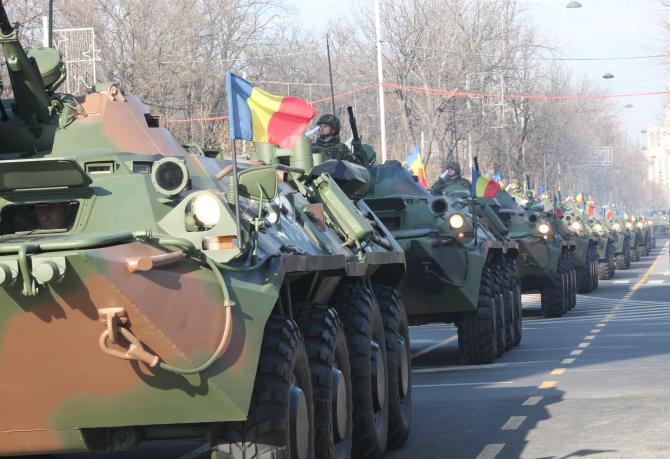
1 December Parade Photo archive: Crișan Andreescu
Currently, tourists arriving in Bucharest on December 1 have the opportunity to see the military parade held every year on the occasion of the national day of Romania. Along the Kiseleff Road, hundreds and hundreds of people, many with children by hand or on their backs, admire the endless rows of soldiers, the military technique or watch the planes and helicopters that cross the sky. It became a tradition that every year, at the Parade, more children are brought along. In summer, however, the Kiseleff Park is an ideal place for strolling and playing, with various places to entertain the little ones. The nostalgics have the opportunity to enjoy the autumn and spring colors of the trees on Kiseleff, which attract even the most indifferent souls.
![]() Fiți la curent cu ultimele noutăți. Urmăriți DCNews și pe Google News
Fiți la curent cu ultimele noutăți. Urmăriți DCNews și pe Google News

















